NORTH WALES COAST
RAILWAY:NOTICE
BOARD
Rheilffordd arfordir gogledd Cymru: Hysbysfwrdd
16 February 2015
 Last issue
Last issue Archive
Archive Share this issue
Tweet
Tweets by @NWrail1
Contributions and comments are encouraged: see the Contributions Page
This site is dedicated to all our regular contributors and supporters, and especially the rail staff of North Wales.
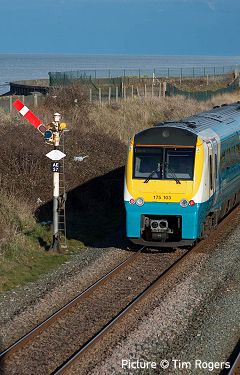
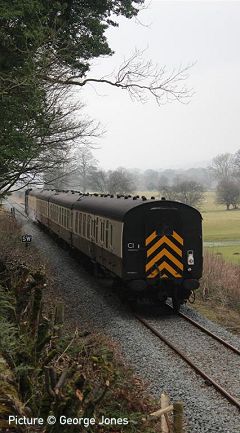
This list may be out of date if you are reading an archived page. For the current list visit our Calendar.
February 2015

Thursday 26 February Merseyside Railway History Group Trevor Gauntlett 'The Halton Curve'
Friday 27 February Great Western Society North West Branch Group Annual Meeting
March 2015
Friday 6 March Clwyd Railway Circle Annual General Meeting followed by an illustrated talk entitled Back to the ‘60s by Geoff Coward
Monday 9 March Wrexham Railway Society: A view from a signal box window: Adrian Bodlander
Thursday 12 March Llandudno and Conwy Valley Railway Society A view from a signal box window: Adrian Bodlander
Friday 13 March Altrincham Electric Railway Society John Sloane 'Chinese Steam in the 80s'. Colour Slide Presentation.
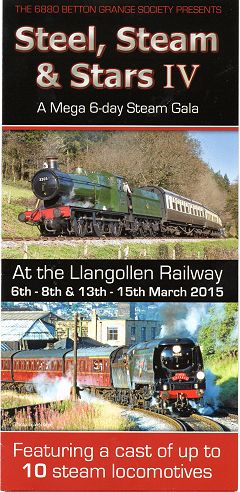
Monday 16 March RCTS Merseyside & North Wales: A History of Railway Preservation in Britain. Robert Gwynne .Bob is the Associate Curator Rail Vehicles at the NRM in York
Thursday 26 March Merseyside Railway History Group AGM Members Slides
Friday 27 March Great Western Society North West Branch Liverpool's Disused Tunnels, by Paul Wright.
April 2015
Thursday 9 April Llandudno and Conwy Valley Railway Society Railway enthusiasm - international: Phil Thomas
Friday 10 April Clwyd Railway Circle The View From a Signalbox Window: Adrian Bodlander
Friday 10 April Altrincham Electric Railway Society Alvin Barker "A Selection of British Transport Films from the Steam Era". Digital presentation.
Saturday 11 April. Excursion. The Great Western Express from Hooton to Worcester and Oxford The railtour is jointly promoted by the Chester Model Railway Club and Ffestiniog Railway Society Dee & Mersey Group. Full details can be found at the Chester Model Railway Club website.
Saturday 11 April Excursion Compass Tours by West Coast. The Wight & Sussex Express to
Portsmouth & Chichester with optional tour of Sussex and Hampshire. from
Hooton, Bache, Wrexham, Gobowen, Shrewsbury, Wellington, Telford, Wolverhampton, Rowley Regis, Stourbridge, Kidderminster and Worcester SH.
Monday 13 April Wrexham Railway Society: Back to the ‘60s :Geoff Coward
Monday 13 April Excursion Compass Tours by West Coast The North York Moors & Heartbeat Explorer. To Whitby, From Chester, Frodsham, Warrington (BQ), Wigan, Leyland, Blackburn, Accrington, Burnley, Hebden Bridge, Sowerby Bridge and Brighouse.
Wednesday 15 April Excursion from North Wales Compass Tours by West Coast The Royal Windsor Express. With an option of a longer break in London (alighting Kensington station)
From Holyhead, Llanfairpwll, Bangor, Llandudno Junction, Colwyn Bay, Rhyl, Flint, Chester, Crewe, Stafford and Lichfield TV to Windsor.
Monday 20 April RCTS Merseyside & North Wales: 21st Century Steam in China. Geoff Coward. Geoff presents video and stills from his visit in 2002.
Friday 24 April Great Western Society North West Branch Standard Gauge Railways of France and Germany, by Barry Rushton
Thursday 30 April Merseyside Railway History Group Geoff Coward Quiz and informal evening
May 2015
Thursday 14 May Llandudno and Conwy Valley Railway Society 6G locomen: personal reminiscences by A Guest Panel
Wednesday 20 May Excursion Compass Tours by West Coast The Cornish Explorer From Chester, Wrexham, Ruabon, Gobowen, Shrewsbury, Craven Arms, Ludlow, Leominster, Hereford & Bristol tp Penzance. The train is routed via the scenic Welsh Marches line, South Wales, the Severn Tunnel, Bristol, Somerset, the Dawlish Sea Wall, Devon and rural Cornwall.
June 2015
July 2015
Friday 3 July Excursion Compass Tours by West Coast The Conway Valley Explorer
Via the Scenic Conway line (with Ffestiniog Railway option). From Grantham, Peterborough, Stamford, Oakham, Melton Mowbray, Leicester, South Wigston, Hinckley, Nuneaton, Tamworth, Lichfield TV, Rugeley TV & Stafford to Betws-y-Coed & Blaenau Ffestiniog.
Saturday 4 July Excursion Compass Tours by West Coast The Conway Valley Explorer From Lincoln, Newark NG, Grantham, Bottesford, Bingham, Radcliffe, Netherfield, Nottingham, Tutbury & Hatton, Uttoxeter, Blythe Bridge & Stoke to Betws-y-Coed & Blaenau Ffestiniog. (with Ffestiniog Railway option).
August 2015
September 2015
Wednesday 9 September Excursion Compass Tours by West Coast The Conway Valley Explorer
Via the Scenic Conway line (with Ffestiniog Railway option) Sheffield to Betws-Y-Coed and Blaenau Ffestiniog. From Sheffield, Rotherham Central, Swinton, Moorthorpe, Normanton, Shipley, Keighley, Skipton, Hellifield, Carnforth & Lancaster.
12 September 2015 Excursion Compass Tours by West Coast The Conway Valley Explorer Via the Scenic Conway line (with Ffestiniog Railway option) Scarborough to Betws-Y-Coed & Blaenau Ffestiniog.eparts – Saturday
From Scarborough, Seamer, Malton, York, Wakefield, Brighouse, Sowerby Bridge, Hebden Bridge, Todmorden & Rochdale.
October 2015
Saturday 10 October 2015 Excursion Compass Tours by West Coast The Conway Valley Explorer
Via the Scenic Conway line (with Ffestiniog Railway option) Hereford to Betws-Y-Coed
Departs – From Hereford, Ledbury, Gt Malvern, Worcester FS, Droitwich, Barnt Green, Walsall & Wolverhampton.
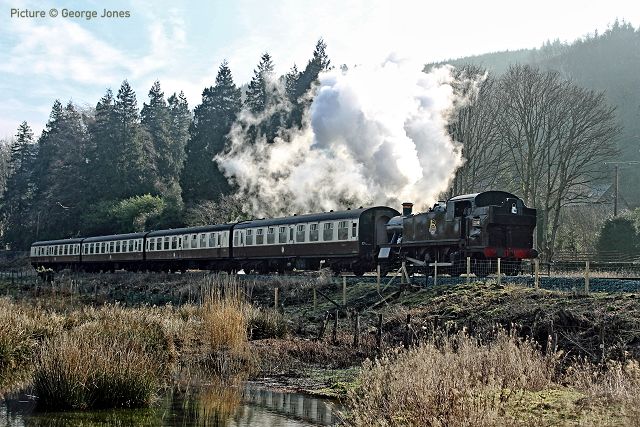
5199 approaches Corwen past the nature reserve with the the 10:40 from Llangollen, 15 February. Picture by George Jones.
Valley Flasks
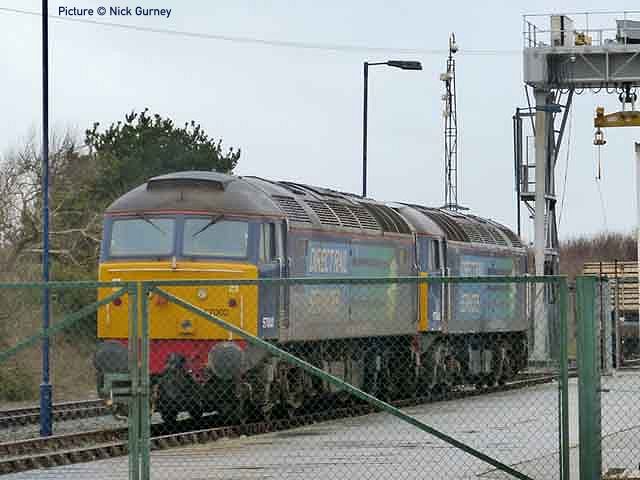
The Valley - Crewe flask train continues to produce a varied selection of motive power; always double-headed, but not always a pair of the same loco type, although 15 February saw a matching couple in charge in the shape of 57 002 and 57 008, seen above at Valley waiting to return with their single flask wagon. Picture by Nick Gurney.
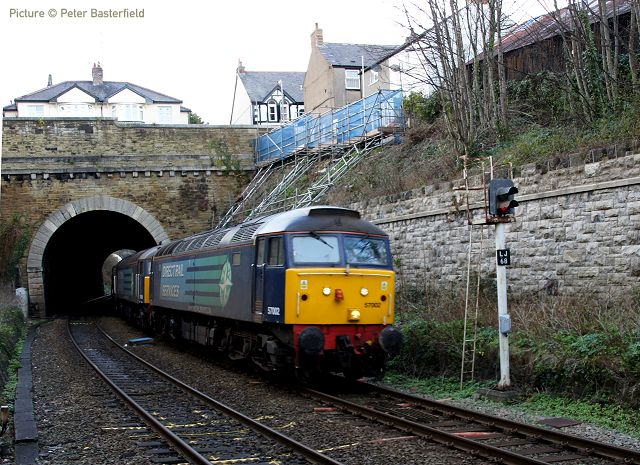
The train emerges from Conwy Tunnel, running almost an hour ahead of its scheduled time (Peter Basterfield). The train terminated at Crewe Coal sidings, heading north to Sellafield the next day, as is the normal procedure. Wylfa, serviced by this train, was the last Magnox power station to be built in the UK and is now the last operational Magnox station in the world. Today, it has only one of its original two reactor still working, and two operational turbine generators, but with an output of around 460MW can supply more than 20 per cent of Wales’s electricity needs.
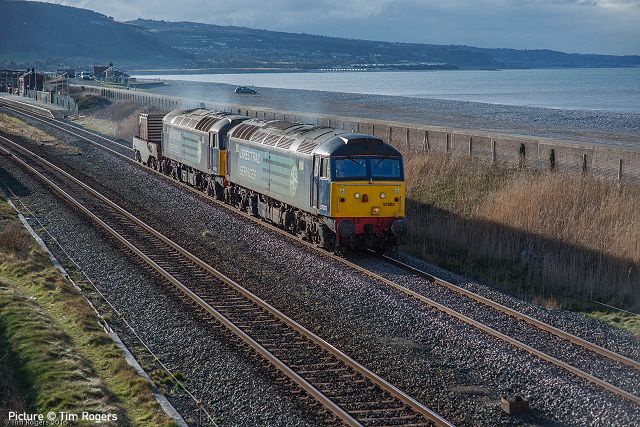
Abergele (Tim Rogers).
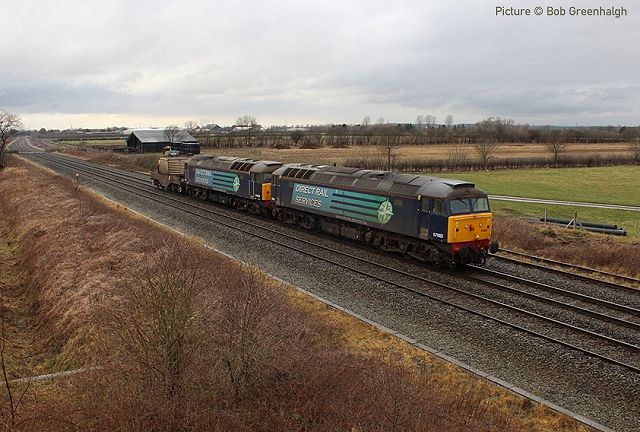
Passing Beeches Farm bridge (Bob Greenhalgh). The twelve '57/0' sub-class locos were the first of the class 57 conversions from Class 47s, commissioned by Freightliner, and are not equipped with heating supply for passenger trains. Freightliner replaced them with new Class 66 locos, and after various changes of ownership nine are operated by DRS and three (001, 005 and 006) belong to West Coast Railways.
Rossett redoubling round-up
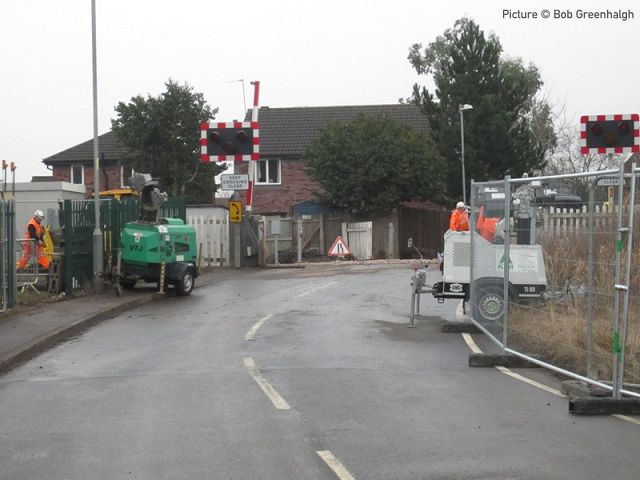
Green Lane crossing, Saltney, pictured on 14 February. Picture by Bob Greenhalgh, who writes: 'Despite only living less than half a mile from the crossing, it was only by chance on Friday 13th I learnt that the crossing was about to close for four weeks as part of the Saltney - Wrexham upgrade. The photo was taken from the boundary fence.'
Elsewhere on the line, Network Rail documents inform: 'From 05:10 on Monday 23 February, the
The existing single line between Rossett Junction at 206m 48ch and Balderton Level Crossing (exclusive) will be slewed onto the new track formation that has recently been installed. Points CR740 at Rossett Junction will continue to be secured out of use, but will become secured out of use in the opposite lie (right-hand switch closed instead of left-hand switch closed).'
At the meeting of Wrexham Railway Society on 9 February, speaker Mr James Jackson of Network Rail gave an in depth review of the project. As the Route Strategy Manager for Wales and the Borders he covered the history of the project and the political initiative which has funded the need to improve journey times between North and South Wales. The following notes from the meeting are by George Jones.
The problems overcome with the former Great Western Railway route, and its recovery from a previous two track railway, were illustrated along the 5.5 mile length. There were more problems with the old formation than expected, especially in terms of drainage for the low-lying landscape.
The modern requirements to upgrade the four level crossings were explained. All four will be full barrier crossings rather than the previous half-barrier. The crossing at Green Lane is currently closed whilst it is widened to improve pedestrian access. The one at Broad Oak, north of Rossett, has the most complex needs as, if a train speed of 90 mph is to be maintained, modern obstacle detection equipment needs to be put in place. The mid and low level radar installation which confirm the crossing is clear was illustrated to aid our understanding. This work follows the decision not to close the crossing or replace it with a bridge.
Coupled with the need to improve the speed of trains south of Gobowen, the finished project will reduce journey times by 15 minutes and is now likely to be completed by November 2015. The benefit of this for passengers will be incorporated into future timetable revisions and is likely to give two trains to and from Cardiff and one to and from Birmingham in each two hour period. Mr Jackson did not rule out later improvements to the line which would see further redoubling north of Wrexham but the replacement of the single line bridge across the A483 would be expensive.
A question was asked about the need to provide an intermediate block at Ruabon to break up the long section between Gobowen and Wrexham which can cause delay when trains are held awaiting the line to clear. This enhancement will have to await a future resignalling project.
Videos to watch - chosen by Dave Sallery
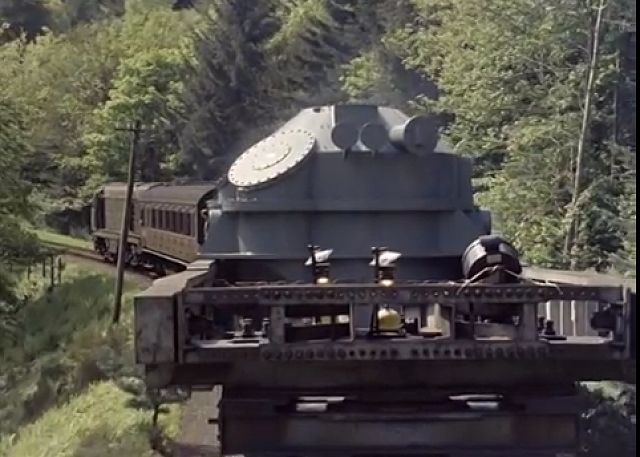
In 1962, a transformer for the Ffestiniog hydro-electric power station was carried by rail from Llandudno Junction to Blaenau Ffestiniog, an operation which needed careful planning; the dimensions of the transformer were dictated by the clearance through the line's bridges and tunnels. The operation was recorded by the British Transport Films Unit, and a 12-minute colour film created which can now be enjoyed on YouTube.
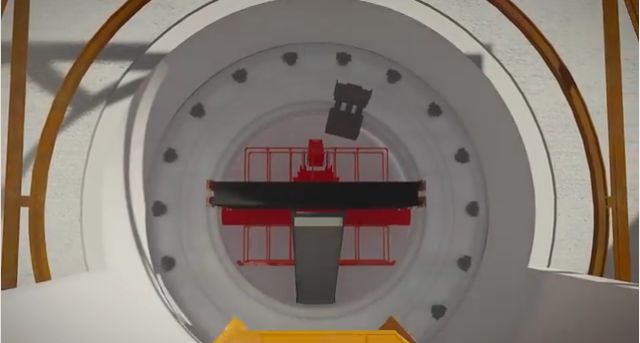
Moving from the past to the future, Network Rail have uploaded a video explaining the forthcoming project to permit the installation of overhead electrification through Farnworth Tunnel between Manchester and Bolton, with the help of some state-of-the art animation.
The history of the twin tunnels at Farnworth is a curious one. Originally there was one double-track tunnel, but when the Lancashire and Yorkshire Railway route north from Blackburn to Hellifield was completed in 1880, the Midland Railway proposed to use this route for a through service between Manchester Victoria and Scotland. It was realised that the Pullman Cars included in Midland trains would not fit safely through Farnworth Tunnel, so a second single-track tunnel was bored alongside for the northbound line, while the southbound line became single track through the original tunnel.
Llangollen Railway news - report by George Jones
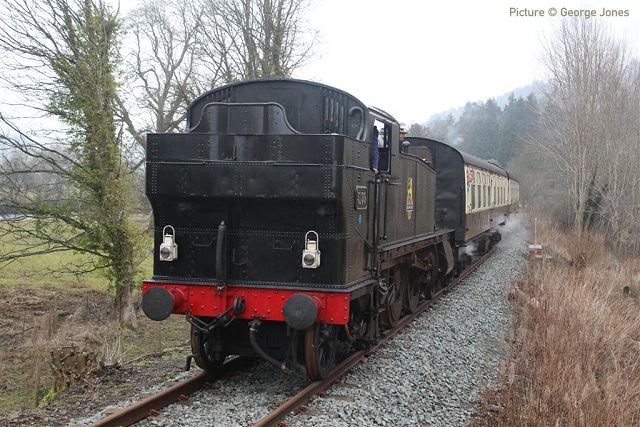
I went to Corwen East to capture the start of the season of regular trains on 14 February; the first arrival, due at 11:20 but a few minutes late. seen above approaching with 2-6-2T 5199 in charge.
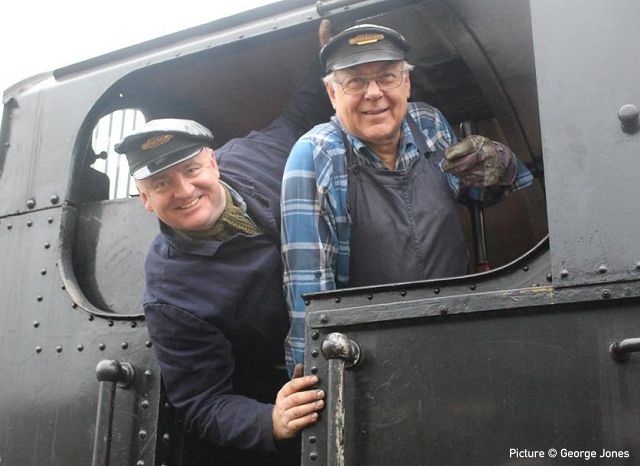
The loco crew.
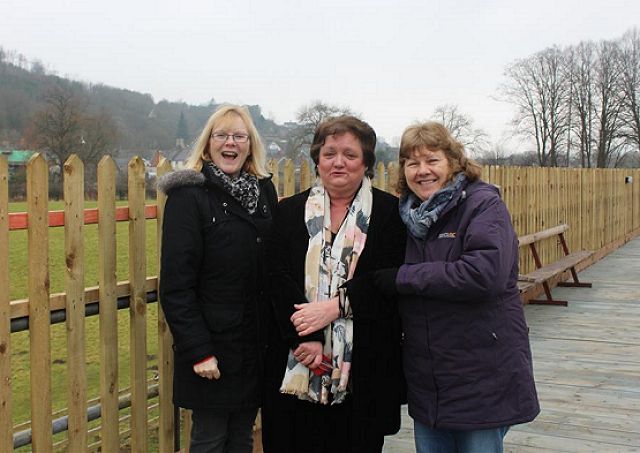
While awaiting the late arrival of the 1120 train people assembled and the first three would-be passengers were three ladies from Rhyl, Corwen and Trevor out to celebrate a get-together.
The weather was overcast and gloomy and not best suited to photography, so I stuck to the platform.
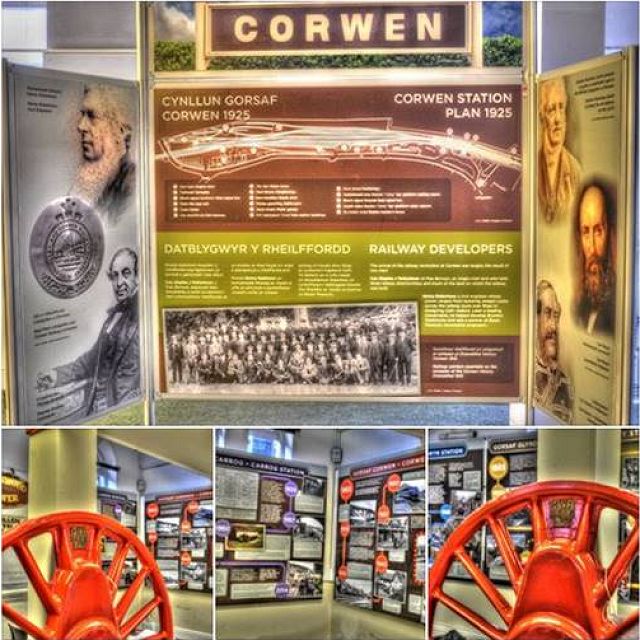
When the train arrived, a group of students on holiday from Hong Kong took in their close encounter with a steam engine. They were encouraged to take a walk around Corwen, finding it different to the other hot spots visited in the UK (!) and enjoyed the newly opened Railway Museum. The exhibition, in the former Oriel gallery / red brick chapel in London Road is now open. One major exhibit is the pattern for the driving wheels of the new-build 47xx 2-8-0, another is the chimney from pannier tank 7754. Included display panels with potted history of the Llangollen - Corwen section, and a video presentation of the preservation scheme.
Missing from the Corwen scene is the Pavilion, now reduced to salvage after demolition and site clearance in progress. Erected in 1911 (apparently using parts from a former tram depot) the building was once an events venue but closed in 2010 due to structural faults and asbestos content. There were attempts to save it, but it was said that repairs would have been too expensive.
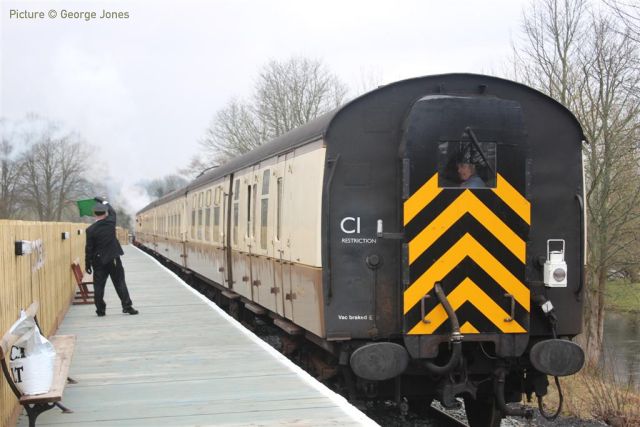
The second train of the day arrived and departed in slightly better weather with a reluctant appearance of some blue sky. Above, the 13:45 departure with 5199 propelling the train and the Remote Control Vehicle (RCV) leading. The locomotive would run round the train on arrival at Carrog.
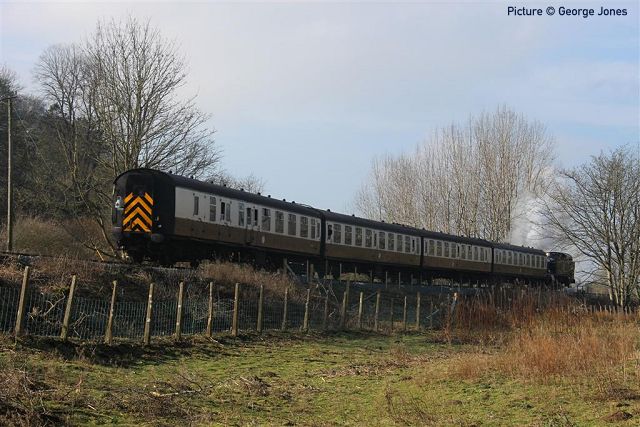
The next day, 15 February, I found blue skies and was tempted to try out a new location for line-siding from the nature reserve established to the east of Corwen East station, accessed via underpass bridge 29 below the platform end. The area now includes a wildlife pond and the view takes in the railway as it begins to climb away from the A5 at Colomendy onto the embankment leading into Corwen. (See also page heading picture.)
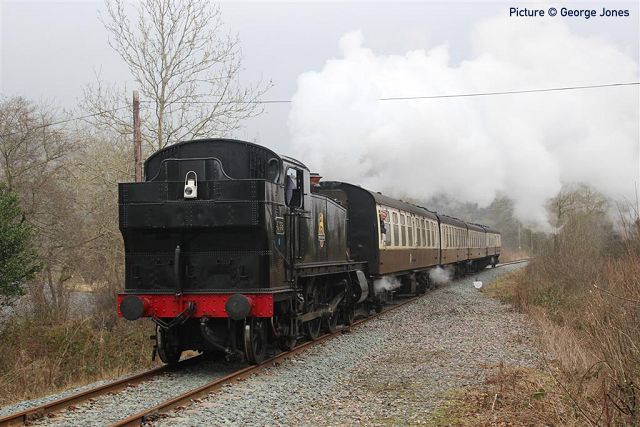
After my 'brunch' at Carrog I went to the Bonwm Gates to await the passing of the 13:00 from Llangollen. This location has a limited car parking option and a close view of the track as it comes round the bend from Plas Bonwm farm where whistling for the crossing gives some warning of the train's approach.
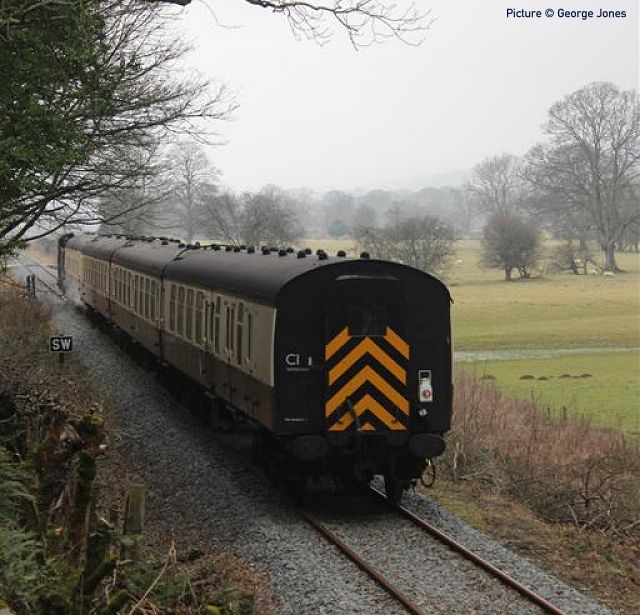
Walking along the A5 past railway milepost 14¼ the low wall and the cut-back vegetation presents a high level view of the return working and the operation of the RCV where 'driver 2' is controlling the train's progress and in communication with the footplate crew.
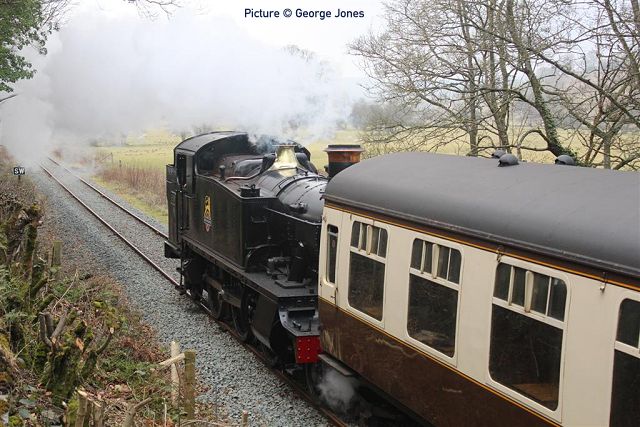
5199 propelling the train presents an unusual operational perspective.
There are various photo options on the Carrog to Corwen stretch, although they do entail some walking as car parking is very limited on this busy and fast stretch of road. A stiff walk between locations will do photo-ers good if they leave the car behind.
See the Llangollen Railway website for timetable and full information.
Llangollen at SCRUA
The public meeting of the Shrewsbury to Chester Rail Users Association, to be be held in Chirk on Tuesday 24th February at 7.30pm at the Chirk British Legion, will feature a talk by Neil Evans of the Llangollen Railway who will speak on the Corwen extension and future plans. All are welcome.
Past Times with John Hobbs - Steam on the Londons, 1965
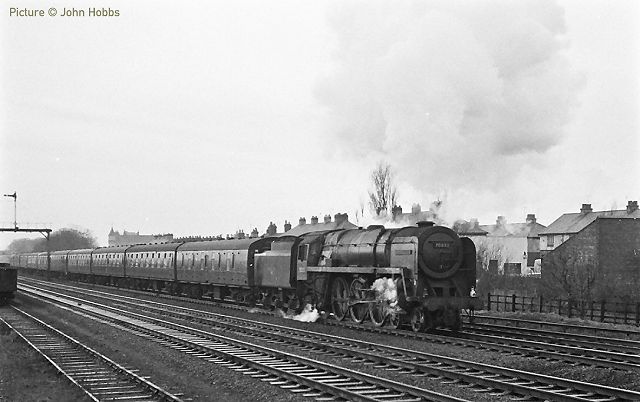
Following on from my previous comments about the conversion of North Wales Coast services to DMU at the end of January 1965 and the contemporary shortage of EE Type 4 (later Class 40) diesels, here are some examples of steam substitution. At the time even the evening 5.50pm Euston to Holyhead "The Emerald Isle Express" was also often steam and the sound of a "Britannia" screaming through Prestatyn, in the dark, at about 10.00pm with the whistle wide open was stirring! It would not last. Above, Britannia Class 4-6-2 70033 Charles Dickens leaves Prestatyn, with the 7.50 am Holyhead to Euston, 'The Emerald Isle Express' on Saturday 23 January 1965, here deputising for an EE Type 4 as this train had been diesel-hauled for years even by 1965.
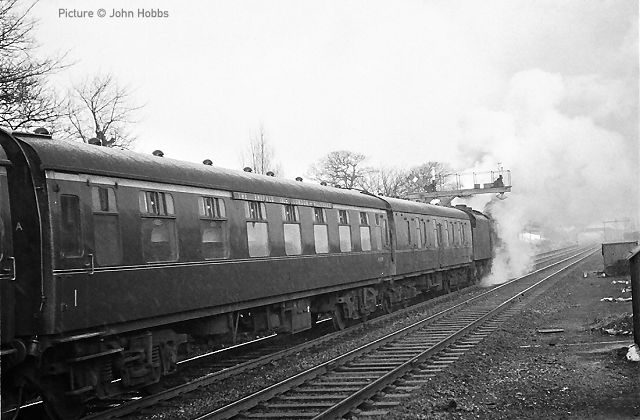
LMS design, BR built, Class 5 4-6-0 44679 leaves Prestatyn on the "Up" slow with the 12.20pm Sundays Only Holyhead to Euston on 10th January 1965; another train which had also been diesel hauled since the late 50s. The roof boards bear testimony to the train's status although it was not officially called 'The Emerald Isle Express' on a Sunday when it served North Wales coast resorts rather than connecting with a boat at Holyhead, as there was no boat connection - the roof boards remained in place all the same!
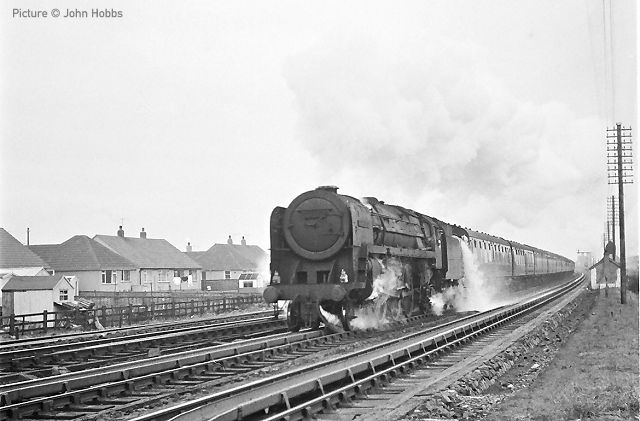
70034 Thomas Hardy leaves Prestatyn with the 11.20am Euston to Holyhead on Saturday 6February 1965; this was formerly the "Welshman"; quite a length even at this time of the year because it now combined with a Manchester to Llandudno Junction service between Chester and Llandudno Junction. The water troughs remain in use and it looks like enough water has been taken. Other trains were now Diesel Multiple Units but the shock of this was lessened by the Londons remaining steam hauled - for a short time.
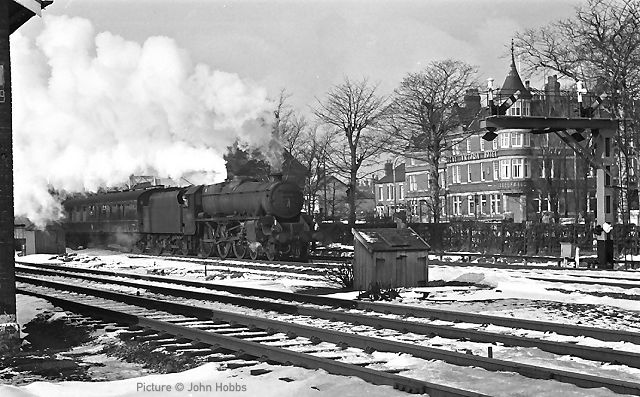
LMS Class 5 4-6-0 45429 leaves Prestatyn with the 9.05am Llandudno to Euston on 5 March 1965; in the background the Royal Victoria Hotel looks magnificent; today, converted to flats, it is not quite such an attraction but one bar remains open. 'Threlfalls' emblazoned across the front of the building, is a blast from the past. A light dusting of snow completes the scene.
Seen at Stafford and Crewe - Pictures by Martin Evans
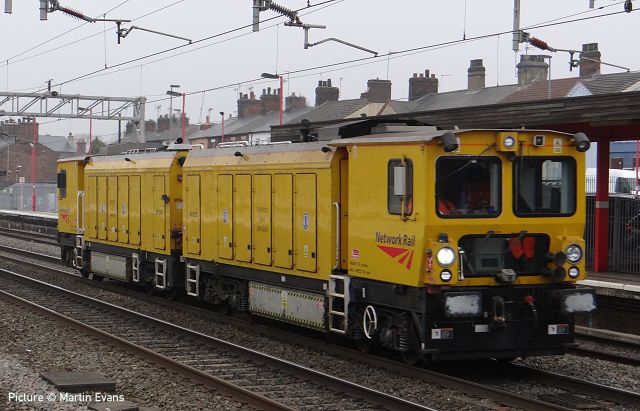
Some pictures from a visit to Stafford on 10 February as part of an RCTS Chester Branch observations exercise. Above, Network Rail rail-grinder 79262/79261 takes the up fast line at Stafford on a Crewe to Crewe working which was travelling as far as Nuneaton.
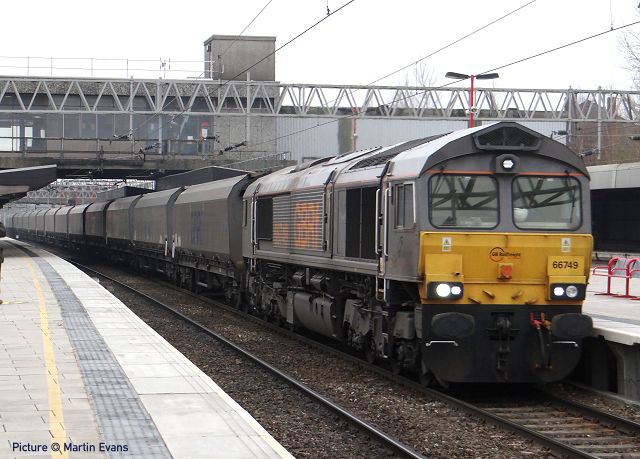
GB Railfreight 66 749 powers through Stafford with an Ironbridge to Tuebrook working of empty biomass hoppers. In 2012, GBRf purchased three Class locomotives that were originally intended to enter service for Crossrail Benelux, but this never happened and had been in store in the Netherlands. After modifications to match the UK locos, they have become 66 747-749, so far retaining their original grey livery.
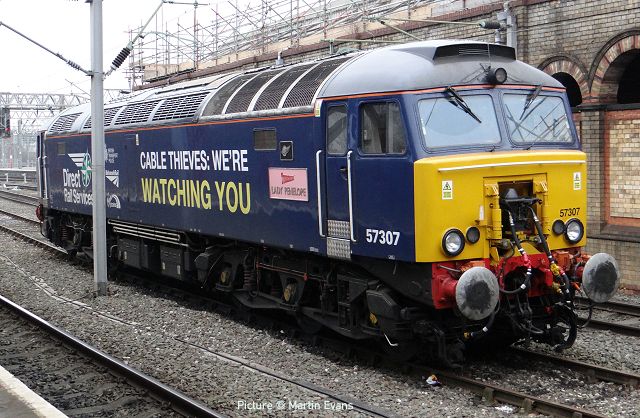
At Crewe in the afternoon, DRS 57 307 Lady Penelope was the Crewe 'Thunderbird'.
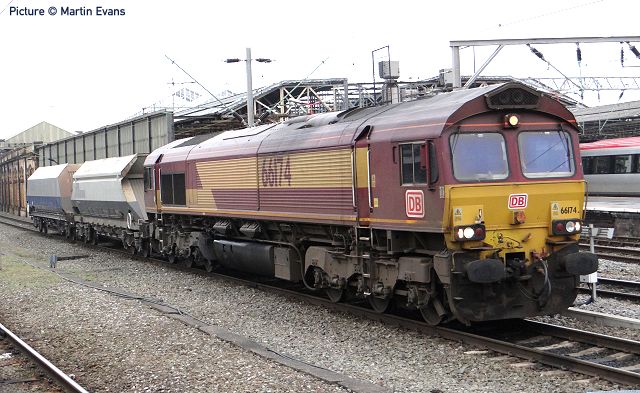
66 174 waiting the 'road' at Crewe with two bogie hoppers, perhaps bound for attention at Marcroft Engineering near Stoke.
Flint memories - by Roger Carvell
I was very moved by the view (see last two issues) of 42727 having just passed over what was Flint Troughs, well to the east of Flint itself. This location is where I did most of my train watching in the 1960s; only a simple wire fence separated the watcher from trains. It reminded me of good times past and of those who are no longer with us. A bit of a lump in the throat to be honest.
This view is only the second I have seen of a train on the troughs there. Odd, as the location was close to the main A548 coast road and easily accessible on foot. Derek Cross did go there in the late 1940s but little else has ever been published. Glantraeth Farm is indeed behind the camera position. For many years a grounded grey brake van of early LMS origin stood in the yard as a
tractor shed.
At the Flint end of the troughs, almost visible in the photo, was another wagon body of ancient LNWR origin, with diagonal outside bracing; that was a railway store, at a guess. Water for the troughs was drawn from the Pandy river in nearby Oakenholt village, beyond the last carriage of 42727's train. Water was stored in a Paterson water softener tank of some height (out of shot in
this view). Years after it had been abandoned I climbed to the top of it. Not for the faint hearted but the views of the River Dee and Wirral were great.
The troughs were still there in 1968, full of water, but I think the facility, so exciting to watch in action, was abandoned and dismantled by 1970. We used to fish in those power station pools alongside 42727. The most vivid memory I have of a steam locomotive there was Ivatt 2-6-0 43007 taking water as it headed towards Chester on a summer Saturday in 1966. Ivatt 2-6-0s of the 4MT type were very rare along the coast.
[It has been pointed out to to us that the signal in the picture is the distant for Pentre Sidings signalbox, not Flint. Pentre sidings box closed in 1967- Charlie]
The Bala to Blaenau line in colour
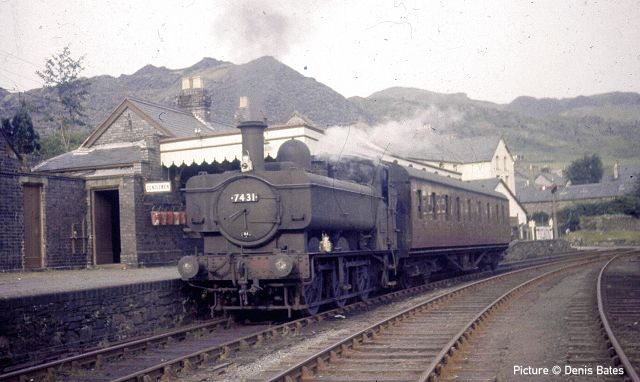
Denis Bates travelled the Blaenau Ffestiniog line in Summer 1959, the year before it was closed t0- passengers, with colour slide film in his camera. The first picture shows pannier tank 7431 standing at Blaenau Ffestiniog Central - the Great Western with the usual one-coach train just arrived from Bala. This station was on the site of the present National Rail station; the Queen's Hotel, still in business today, can be seen in the background.
The coach looks like a Great Western 'B set' vehicle, but we are open to correction on this.
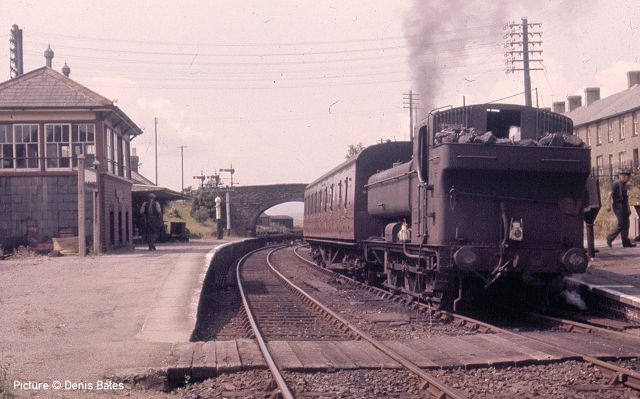
The pannier tank 7431 has run round its train at Blaenau, and is calling at Trawsfynydd on the return journey. 7431 was built in 1948 at Swindon Works to a Great Western design, entering service after nationalisation in 1948. It carries the 'shed plate' 84J indicating allocation to Croes Newydd, or one of its 'sub-sheds' at Bala, Trawsfynydd and Penmaenpool, so it was no doubt a regular performer on this duty. The BR Database website has it allocated to Shrewsbury until transfer to Croes Newydd in early 1961; apparently an inaccurate record. An undated picture of the same machine, carrying the code 6C after Croes Newydd had been transferred to the London Midland Region, appears in our 31 March 2014 issue. It was scrapped in 1964 after only 16 years' use.
'Irish Mancunian' scenes
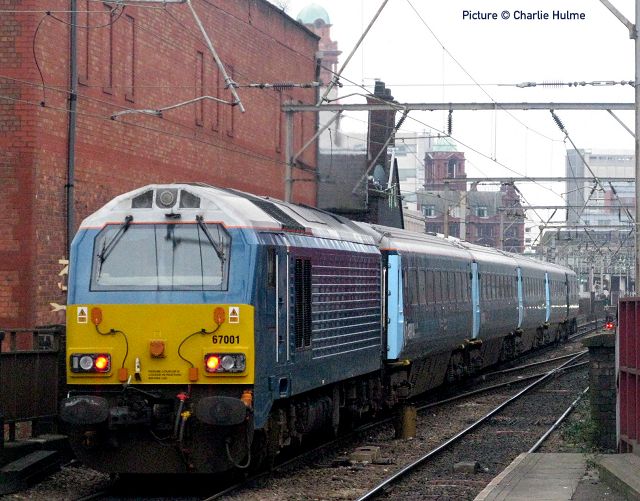
Train 1H89, the 13:01 (SX) Holyhead - Manchester is understandably a popular subject for pictures, even though loco 67 001 is the only one that has worked this train and its associated workings since the new service began before Christmas 2014, although there have been occasional substitutions by a Class 175 set. A case of 'If it's not broke, don't fix it' perhaps. The loco is usually on the rear eastbound, as seen in these pictures; above, on 12 February passing Deansgate station heading for Manchester Piccadilly (Charlie Hulme).
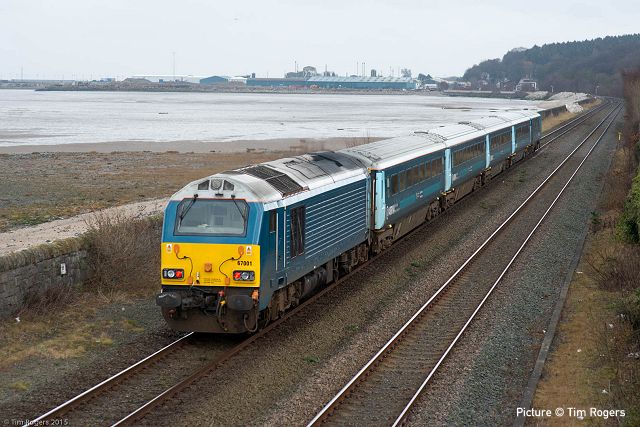
Approaching Mostyn on 13 February (Tim Rogers).
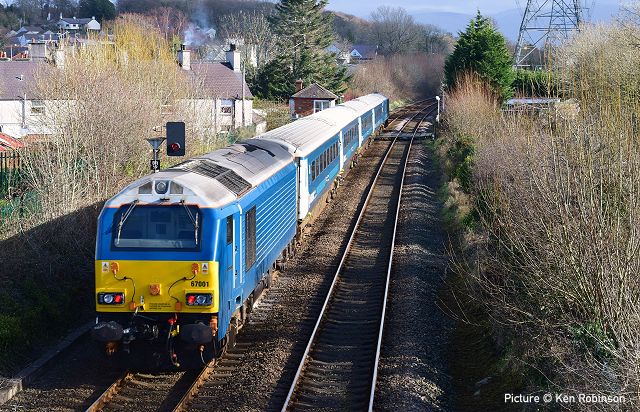
Sunny Llanfair PG on 16 February (Ken Robinson). Note the signal, BR59, whose head appears to be floating on air: its original three-lamp head has been replaced by a modern LED version which can show red, yellow or green with just one lamp, bracketed almost invisibly on to the edge of the original base, to give drivers a better sighting.
Sun, Sea and Semaphores at Abergele - pictures by Tim Rogers
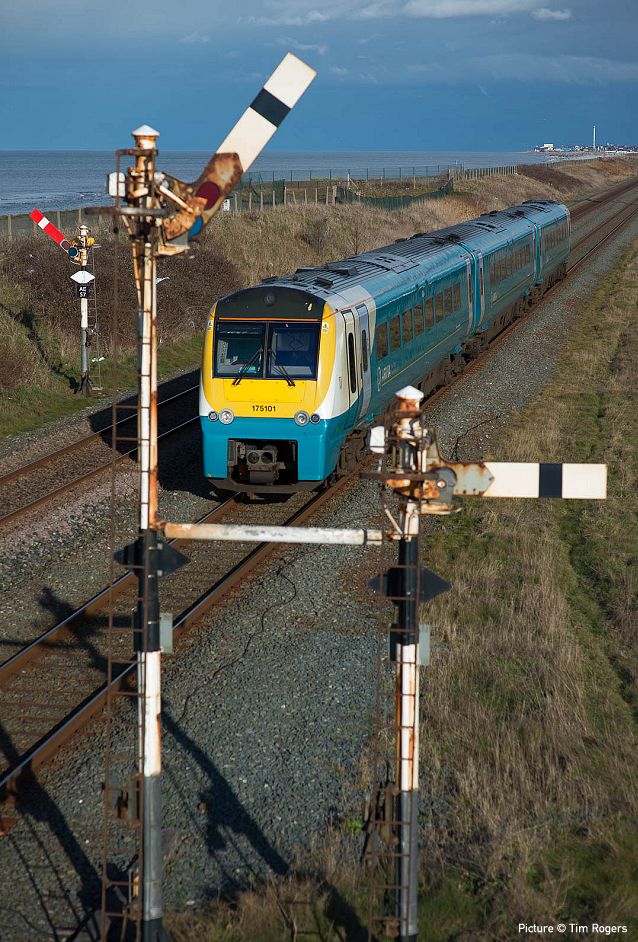
Train 1W93 11:21 Cardiff Central to Holyhead, approaches Abergele on 13 February in the classic 'framed' view. A slightly unusual sight: 158s are most commonly seen on Cardiff - North Wales trains, but 175 101 is working on this occasion. Is that normal for this service?
The two-arm junction signal, which shows drivers whether they are signalled for the platform line on the main line, replaced a life-expired traditional junction signal with a single main post branching into two short posts carrying the arms. The London Midland Region decided to replace it with two separate posts, and the story goes that drivers protested that it didn't look like a 'proper' junction signal. The solution was to send someone to a DIY warehouse and purchase a length of plastic drainpipe which was painted white and fixed between the two arms.
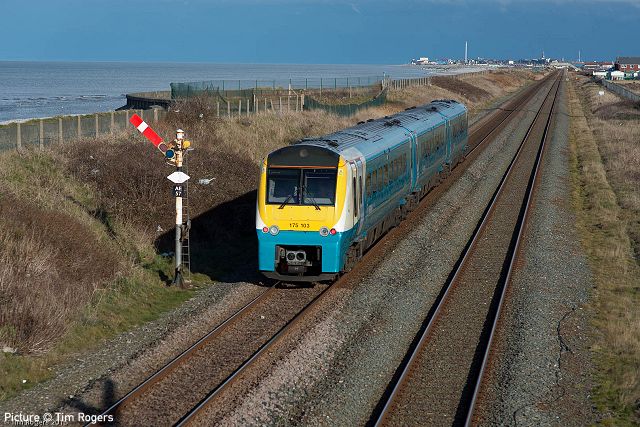
175 103 passes Abergele starter signal AE57 with 1H90 14:40 Llandudno to Manchester Piccadilly on 13 February. Great changes are planned at this station in Network Rail's master plan to control everything from Cardiff: the signalbox will disappear, the platform loop will be removed (replaced by a new loop at Rhyl) and the 'down' platform widened to reach the remaining down line.
The line at this point is perfectly straight and also level. On the horizon is the 73-metre 'Sky Tower' at Rhyl, purchased in 1993 from the Glasgow Garden Festival, which offered views of the sea, mountains and passing trains through its (scratched) windows until it was closed in 2010.
Manchester area freights
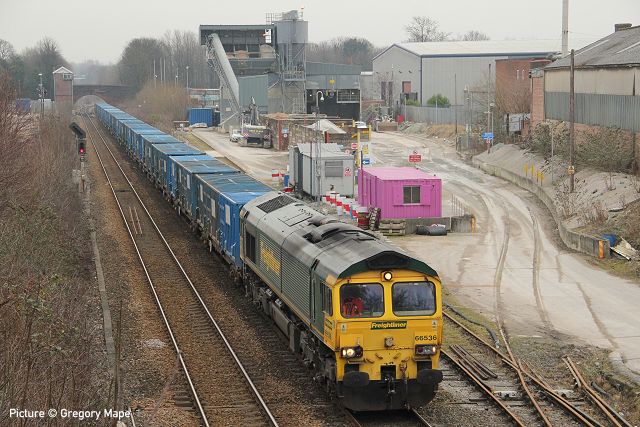
66 536 on 12 February's Bredbury to Runcorn Folly Lane 'Binliner' Greater Manchester refuse train passing the site of Northenden Station and former station goods sidings, once a Blue Circle cement but now occasionaly used by stone trains, although the rails are looking rather rusty.
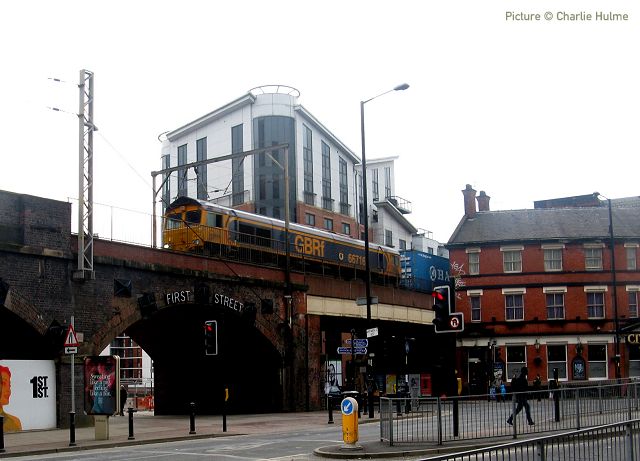
On 12 February, the GB Railfreight 14:18 Trafford Park to Felixstowe container train, hauled by 66 716 Locomotive and Carriage Institution Centenary 1911-2011 emerges between the Victorian City Road Inn and a pig-ugly new building between Deansgate and Manchester Oxford Road.
North Wales Coast home page | Archive | Previous Notice Board